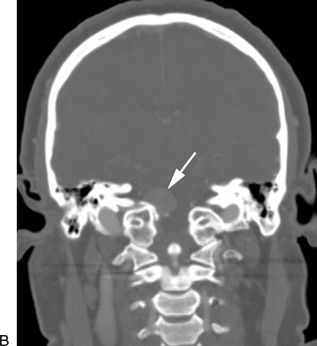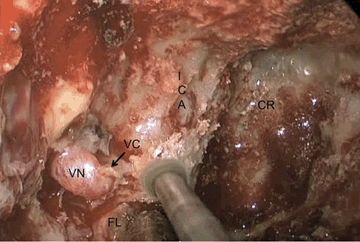
FIGURE 28.1 T1-weighted, postcontrast axial MRI (A) and coronal CT angiogram (B) showing a small medial jugular tubercle meningioma (arrows). The tumor originates medial to the lower cranial nerves, making it ideal for a medial (endonasal) approach.
Malignancies of the nasopharynx are usually advanced at the time of presentation and are treated primarily with radiation therapy. The primary role of surgery is biopsy for diagnosis and debulking of tumor to relieve symptoms prior to radiation therapy. Exceptions include small tumors that can be completely resected with adequate margins. For adenoid cystic carcinoma, the goal of surgery is maximal removal with minimal morbidity, followed by radiation therapy. It is not possible to achieve clear resection margins with adenoid cystic carcinoma of the skull base due to perineural spread, and the extent of surgery is limited by the surrounding neural and vascular structures. Surgical salvage of residual tumor following radiation therapy is of potential value for local control and should be considered based on posttreatment functional imaging with PET–CT or the results of biopsies. Understanding the paramedian anatomy below the petrous ICA is critical for safely expanding the above indications.
CONTRAINDICATIONS
There are no absolute contraindications to an endonasal approach as long as the tumor is medial to the lower cranial nerves. Occlusion of the contralateral ICA warrants consideration of a posterolateral approach that would avoid any potential risk to the patent ICA. Extensive tumor (benign or malignant) with encasement of the ICA limits the goals of surgery, and complete resection is not possible without sacrifice of the ICA. Depending on the surgeon’s experience and available resources for dealing with an injury to the ICA, an open approach with better proximal and distal control of the ICA may be preferred. Any sinus infection would need to be properly treated before intradural surgery is performed, but sinusitis can usually be cleared within a week or two with antibiotics, drainage, or a combination of therapies.
PREOPERATIVE PLANNING
This region is difficult to image due to the dense bone and closely associated mucosal surfaces, muscles, vessels, and nerves. As a result, MRI and CT are complementary imaging modalities, and often both are needed to establish a differential diagnosis and determine extent of disease. Fine-cut T2-weighted MRI or FIESTA sequences can be critical in determining the relationship of the lower cranial nerves to any lesion in the infrapetrous space. Postcontrast T1-weighted images can help to reveal the vascularity of a tumor or the presence of a dural tail. CT is critical, especially for small lesions of the petrous bone that can be quite heterogeneous on MRI. Even asymmetric petrous pneumatization can be deceiving until evaluation with CT. The addition of CT angiography is important to define the vascular relationships and involvement, especially of the ipsilateral ICA and vertebral artery. Combined PET–CT scan imaging is helpful in differentiating cancer from radiation changes in patients with recurrent or residual sinonasal malignancy.
A full swallowing evaluation is necessary to identify cranial nerve deficits and assess the risk of perioperative complications related to airway obstruction or aspiration. Complete vocal cord paralysis or significant aspiration may require prophylactic tracheostomy to prevent aspiration in the perioperative period. The detection of cranial nerve dysfunction by physical examination or electromyography can provide prognostic information regarding the potential for additional nerve injury or recovery.
SURGICAL TECHNIQUE (VIDEO 28.1)
All EES is best performed by a team of two surgeons, composed of otolaryngology and neurosurgery specialties. Patients are positioned supine and preferably in head pin fixation with the head in slight extension and laterally flexed to point the chin at the surgeons, both of whom stand on the patient’s right side (right-handed surgeons). Oxymetazoline (0.05%)-soaked pledgets are placed in the nose, image guidance is registered, and the midface and abdomen are prepped and draped. Antiseptics are not used intranasally except for the nasal vestibule.
Intradural cases or those with significant ICA exposure should have a vascularized nasal septal flap (see Chapter 42) harvested from the side contralateral to the infrapetrous approach at the beginning of the operation. The right middle turbinate is frequently resected to allow working room for the endoscope, and the sphenoid sinus is opened widely, fully exposing the lateral recess on the operative side. The key to accessing the infrapetrous region is a medial maxillary antrostomy and transpterygoid approach.
A maxillary antrostomy is performed on the same side as the lesion. The sphenopalatine artery is sacrificed, and the sphenopalatine foramen is enlarged with a 1-mm Kerrison rongeur. The bone of the posterior wall of the maxillary sinus is removed to fully expose the contents of the pterygopalatine space. Within the sinus, the infraorbital nerve (branch of the maxillary nerve) is identified along the floor of the orbit as it courses medially toward the foramen rotundum. Medially, at the inferior margin of the sphenoidotomy, the palatosphenoidal (palatovaginal) vessel is sacrificed, and the soft tissues of the pterygopalatine space are elevated from the underlying bone to identify the vidian canal within the base of the pterygoid bone. It is difficult to identify the canal without first sacrificing the terminal branches of the internal maxillary artery.
The vidian nerve and its canal are a key anatomic landmark for this approach. The pterygopalatine contents should be carefully retracted laterally to identify the vidian nerve as it enters the bony canal within the pterygoid base. The vidian canal angles posterolaterally toward the anterior genu of the petrous ICA. However, the vidian nerve crosses over the petrous ICA lateral to the genu to originate from the greater superficial petrosal nerve on the floor of the middle fossa. The pterygoid base must be drilled to define the course of the petrous ICA and provide localization of the anterior genu of the carotid and foramen lacerum (Table 28.1). The pterygoid/vidian canal serves as a good guide during this drilling, especially if the lateral recess of the sphenoid is poorly pneumatized. Drilling the bone of the “pterygoid wedge” (the medial extension of the pterygoid base onto the sphenoid floor) along the path of the vidian nerve will lead to the ICA genu (Figs. 28.2 and 28.3), but it is critical to understand that the vidian nerve crosses the ICA immediately lateral to the genu. Lateral exposure is limited by the vidian nerve and descending palatine branch of the second division of the trigeminal nerve. Both nerves can be skeletonized with careful drilling and released from their respective canals with an attempt at preservation of function. Greater exposure of the ICA, however, usually requires sacrifice of the vidian nerve.
Table 28.1 Segments of the Cranial Base Internal Carotid Artery and Associated Endonasal Anatomic Landmarks for Localization





